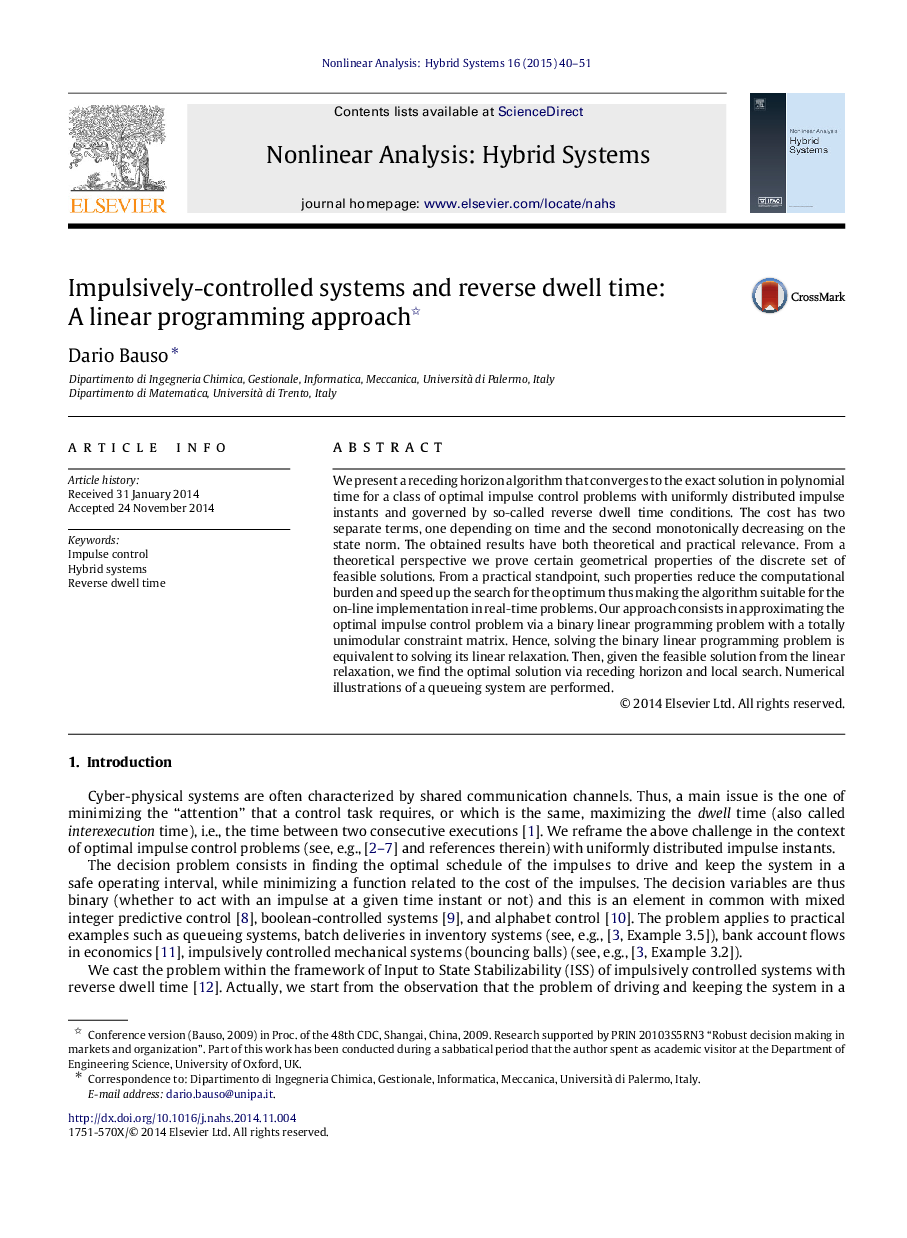| کد مقاله | کد نشریه | سال انتشار | مقاله انگلیسی | نسخه تمام متن |
|---|---|---|---|---|
| 1713507 | 1519825 | 2015 | 12 صفحه PDF | دانلود رایگان |
عنوان انگلیسی مقاله ISI
Impulsively-controlled systems and reverse dwell time: A linear programming approach
ترجمه فارسی عنوان
سیستم های کنترل شده با انفجار و زمان معکوس: یک روش برنامه نویسی خطی
دانلود مقاله + سفارش ترجمه
دانلود مقاله ISI انگلیسی
رایگان برای ایرانیان
کلمات کلیدی
کنترل نفوذ، سیستم های ترکیبی زمان برگشت معکوس،
ترجمه چکیده
ما یک الگوریتم افق عقب را ارائه می دهیم که در زمان چندجملهای برای یک کلاس از کنترل های کنترل ضربان مطلق با لحاظ مودم یکنواخت توزیع شده و با شرایط به اصطلاح معکوس معکوس ادغام می شود. هزینه دو اصطلاح جداگانه دارد، یکی بسته به زمان و دیگری یکنواختی را بر اساس هنجار دولت کاهش می دهد. نتایج به دست آمده ارتباطات نظری و عملی دارند. از دیدگاه نظری، خصوصیات هندسی مشخصی از مجموعه گسسته راه حل های قابل اجرا را ثابت می کنیم. از دیدگاه عملی، چنین خواص، باعث کاهش بار محاسباتی و سرعت جستجو برای بهینه می شود و بدین ترتیب الگوریتم مناسب برای پیاده سازی خط بر روی مشکلات زمان واقعی است. رویکرد ما این است که تقریبأ مشکل کنترل پالس بهینه را از طریق یک مسئله برنامه نویسی خطی دوتایی با یک ماتریس محدود کاملا غیرمجاز تنظیم کنیم. از این رو، حل مسئله برنامه نویسی خطی باینری معادل حل کردن آرام سازی خطی آن است. سپس، با توجه به راه حل عملی از آرام سازی خطی، ما راه حل بهینه را از طریق افق افقی و جستجوی محلی پیدا می کنیم. تصاویر عددی سیستم صف بندی انجام می شود.
موضوعات مرتبط
مهندسی و علوم پایه
سایر رشته های مهندسی
کنترل و سیستم های مهندسی
چکیده انگلیسی
We present a receding horizon algorithm that converges to the exact solution in polynomial time for a class of optimal impulse control problems with uniformly distributed impulse instants and governed by so-called reverse dwell time conditions. The cost has two separate terms, one depending on time and the second monotonically decreasing on the state norm. The obtained results have both theoretical and practical relevance. From a theoretical perspective we prove certain geometrical properties of the discrete set of feasible solutions. From a practical standpoint, such properties reduce the computational burden and speed up the search for the optimum thus making the algorithm suitable for the on-line implementation in real-time problems. Our approach consists in approximating the optimal impulse control problem via a binary linear programming problem with a totally unimodular constraint matrix. Hence, solving the binary linear programming problem is equivalent to solving its linear relaxation. Then, given the feasible solution from the linear relaxation, we find the optimal solution via receding horizon and local search. Numerical illustrations of a queueing system are performed.
ناشر
Database: Elsevier - ScienceDirect (ساینس دایرکت)
Journal: Nonlinear Analysis: Hybrid Systems - Volume 16, May 2015, Pages 40-51
Journal: Nonlinear Analysis: Hybrid Systems - Volume 16, May 2015, Pages 40-51
نویسندگان
Dario Bauso,
